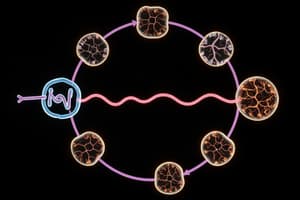Podcast
Questions and Answers
What is the principle behind Radioimmunoassay?
What is the principle behind Radioimmunoassay?
- Separation of bound antigen from the free form using suitable techniques
- Production of an antibody when an antigen is injected into a heterologous animal species (correct)
- Direct measurement of radioactive antigen-antibody fraction
- Measurement of radioactivity using a radioactive counter
What is the purpose of using excess antibody in Immunoradiometric Assay?
What is the purpose of using excess antibody in Immunoradiometric Assay?
- To ensure the binding of all the antigen molecules (correct)
- To measure the radioactivity
- To separate the antigen-antibody complex
- To immobilize the target compound on a solid surface
What is the main function of Enzyme-linked Immunosorbent Assay (ELISA)?
What is the main function of Enzyme-linked Immunosorbent Assay (ELISA)?
- Immobilizing the target compound on a solid surface
- Detecting and quantifying soluble substances such as proteins and hormones (correct)
- Measuring radioactive antigen-antibody fraction
- Separating bound antigen from the free form
What is the role of a radioactive counter in Radioimmunoassay?
What is the role of a radioactive counter in Radioimmunoassay?
How does Antibody-linked Immunosorbent Assay (ELISA) detect target compounds?
How does Antibody-linked Immunosorbent Assay (ELISA) detect target compounds?
Flashcards are hidden until you start studying
Study Notes
Principles of Radioimmunoassay
- Utilizes competitive binding between a radiolabeled antigen and an unlabeled antigen to measure hormone or drug levels.
- The principle is based on the ability of antibodies to differentiate between similar antigens, allowing quantification of target molecules through the detection of radioactivity.
Purpose of Excess Antibody in Immunoradiometric Assay
- Excess antibody ensures that all available antigens in a sample are bound, enhancing assay sensitivity.
- This minimizes variability in measurement and leads to more accurate quantification of the target analyte.
Function of Enzyme-linked Immunosorbent Assay (ELISA)
- Detects and quantifies proteins, hormones, antibodies, and other compounds in a sample using enzyme-linked antibodies.
- The enzymatic reaction produces a measurable signal, typically a color change, indicating the presence and concentration of the target compound.
Role of a Radioactive Counter in Radioimmunoassay
- Detects and quantifies the level of radioactivity emitted from the radiolabeled antigens and antibodies.
- Provides a means to determine the concentration of the target substance in a sample based on the ratio of bound to free radiolabeled antigens.
Detection Mechanism of Antibody-linked Immunosorbent Assay (ELISA)
- Involves the binding of target compounds to specific antibodies coated on a solid surface, allowing for selective detection.
- A secondary enzyme-linked antibody binds to the target compound, enabling signal amplification through a colorimetric or fluorescent reaction, indicating the presence of the target.
Studying That Suits You
Use AI to generate personalized quizzes and flashcards to suit your learning preferences.




